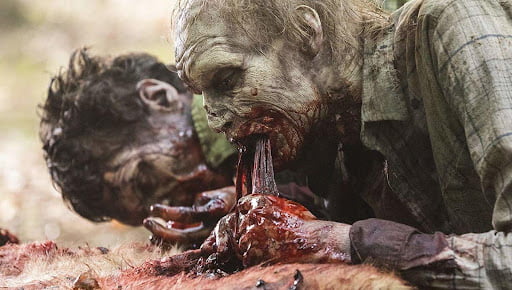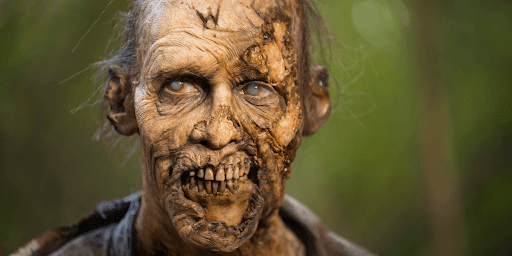Their existence defies the natural order, their insatiable hunger for human flesh contrasting sharply with the dormant state of their decaying bodies. Yet, amidst the chaos, a question looms. How do zombies detect humans, driven solely by their primal instincts, detect the presence of the living?
The answers lie in a complex interplay of these creatures’ remaining senses – those twisted and amplified by the unnatural forces that reanimate them. From their uncanny olfactory prowess to their crude but effective auditory perception, zombies exhibit behaviors that underscore their role as predators.
This exploration into the intricacies of zombie detection offers not only a glimpse into the eerie psyche of these creatures but also provides invaluable insights for survivors struggling to outsmart the relentless pursuit of the undead.
Sensory Mechanisms in The Undead
Sensory mechanisms take on a new dimension, where the once-familiar senses of life have transformed into tools of survival in death. While zombies lack the intricate sensory systems of their living counterparts, their remaining abilities have undergone a twisted evolution that aligns with their insatiable hunger for living flesh.
These mechanisms, guided by a relentless and primal instinct, enable them to navigate their environment with eerie precision. The transformation of their senses is a testament to the resilience of life’s fundamental drives, even in the face of death’s relentless grip. Through these warped senses, zombies respond to stimuli, seeking out their next meal with an uncanny determination.
As survivors grapple with the new normal of a world turned upside down, comprehending the intricacies of these sensory mechanisms is not just a matter of curiosity but a vital key to devising strategies that might tip the scales in favor of the living. With the study of zombie senses, we glimpse the eerie symphony that guides their behavior, offering a window into the psyche of creatures whose existence defies the laws of nature and science.
Sense of Smell and Its Role
A peculiar aspect of zombie behavior lies in their heightened sense of smell, a trait that defies the deteriorated state of their bodies. Despite the advanced stages of decay and decomposition, zombies possess an uncanny ability to detect the scent of humans from surprisingly considerable distances.
This heightened olfactory sense serves as their primary means of detection, drawing them inexorably toward potential sources of sustenance. It’s a phenomenon that raises questions about the nature of their reanimated existence and the mysterious forces that grant them this macabre olfactory prowess.
While zombies might lack the cognitive ability to interpret the subtleties of various odors, their ability to hone in on the distinct scent of living flesh showcases the degree to which their instincts have been magnified in death. The olfactory landscape of the undead, although distorted and focused almost exclusively on one purpose, becomes a driving force that shapes their relentless pursuit of the living.
In a world where survivors must navigate through the shadows to remain undetected, understanding the nuances of zombie olfaction provides an opportunity to strategize, exploit weaknesses, and ultimately increase the odds of human survival against these formidable, albeit decaying, adversaries.
Sound as a Clue to Human Presence
In the desolate post-apocalyptic landscapes, sound has transformed into an inadvertent beacon for zombies, triggering their primal instincts with eerie precision. While zombies might lack the cognitive faculties to comprehend complex sounds, their acute hearing has become a critical component of their detection mechanism.
The faintest noises can set off a chain reaction, causing these undead predators to turn and shuffle toward the origin of the sound, driven by an instinctual need for sustenance. This acute auditory perception, honed by the eerie silence that now pervades the world, has turned even the slightest rustle of leaves or the softest footfall into potential death sentences for the unsuspecting living.
In this grim new reality, survivors soon grasp that even their most carefully calculated movements can unleash consequences. They become acutely aware of the resonance of every step, the subtlety of every breath, and the unintended echoes of every object they displace. Every noise, no matter how insignificant, has the potential to reverberate through the stillness, reaching the sensitive ears of nearby zombies.
The survivors’ journey, once marked by a rhythm of vibrant life, now follows a tense and silent cadence, where the pause between heartbeats and the hesitation before the next step becomes the battlegrounds upon which the conflict between survival and detection unfolds.
Visual Recognition and Movement
In the twisted realm of the undead, where the boundary between life and death, zombies exhibit a rudimentary form of visual recognition that defies their decaying nature. While their optical systems lack the complexity of those in the living, these creatures can detect movement and respond to visual cues in a manner that misrepresents their grotesque appearance. This survival-driven adaptation allows them to identify potential sources of sustenance – living humans – with a primal accuracy.
Although clouded by decay, Zombies’ eyes appear to retain an uncanny ability to detect movement against the backdrop of their decaying surroundings. This eerie vestige of their former humanity gives rise to a unique dance between the living and the undead, where the former strive to remain unseen, and the latter relentlessly seek movement as an indicator of life. Survivors quickly learn that the key to evading detection lies in hiding and mastering the art of motionlessness.
As survivors navigate the post-apocalyptic landscape, they grapple with the challenge of blending into a world that is now teeming with the undead. They discover that the mere act of remaining still, of suppressing even the slightest twitch, can be a shield against detection. Walls become allies, and shadows transform into sanctuaries as survivors learn to minimize their movements, holding their breaths and silencing their heartbeats as if their lives depend on it – which, indeed, they do.

Vibration and Footstep Detection
In the grim symphony of the post-apocalyptic world, even the faintest vibrations caused by footsteps become a telltale sign of nearby human presence. The ability of zombies to detect these subtle tremors is a testament to their heightened sensitivity, a trait that emerges from their macabre transformation. Although lacking the complexity of the human nervous system, zombies possess a basic form of vibration detection, enabling them to perceive the minuscule disruptions caused by movement on the ground.
As survivors tread cautiously through the ruins of civilization, they face the challenge of traversing a landscape fraught with potential danger. They must weigh the trade-off between speed and silence with each step, knowing that even the gentlest footfalls could betray their whereabouts to the ever-vigilant undead. The world becomes a sonic tapestry where the rhythm of survivors’ movements can either blend into the cacophony of destruction or stand out as a discordant note that beckons the undead.
Survivors quickly adapt, using their understanding of the undead’s sensitivity to vibrations to their advantage. They craft footwear designed to silence the impact of their steps, layering fabric and materials to absorb the vibrations that would otherwise announce their presence. They become masters of reading the terrain, knowing which surfaces transmit vibrations more readily and which offer a chance for stealthy passage. Once thoughtlessly taken, each step becomes a deliberate calculation – a negotiation between the need for progress and the imperative of remaining unnoticed.
The dance of survival is elevated to a new level as survivors become attuned to the symphony of their environment. Every footfall becomes a note in this grim composition, where the rhythm and intensity of vibrations dictate the course of action. And while the undead’s ability to detect vibrations poses yet another challenge for survivors, it also underscores the unbreakable connection between the living and their environment. In a world where every motion has consequences, the survivors’ understanding of vibration detection becomes crucial in their ongoing struggle for survival.
Impact of Environmental Factors
In the post-apocalyptic landscape where the undead roam, the environment plays a significant role in shaping the dynamics of zombie detection. The interactions between weather conditions, ambient noises, and terrain can dramatically influence how zombies perceive and respond to the presence of living beings. Survivors quickly learn that factors once taken for granted – rain, wind, darkness – can provide a shroud of protection or become harbingers of danger, depending on how they impact the undead’s sensory mechanisms.
Rainfall, for instance, can be a double-edged sword. While it may muffle the sound of footsteps, it also has the potential to distort scents, making detection through smell less acute. Survivors navigate the downpour with a sense of cautious relief, knowing that their audible footprint might be less pronounced but also aware that the dampening of scent isn’t guaranteed protection. Similarly, fog and mist can obscure visibility, potentially giving survivors an advantage. Still, they also heighten the reliance on other senses like hearing and smell, which zombies have amplified in their new state.
Darkness, once a familiar nighttime companion, becomes a strategic resource for survivors. While zombies may not possess night vision, they utilize their heightened senses to compensate for their visual limitations. In the absence of light, their hearing and sense of smell become even more pronounced, making it crucial for survivors to manage their movements, sounds, and scents. Shadows become both sanctuaries and potential traps, and the survivors’ mastery of exploiting darkness can mean the difference between evading detection and facing the hungry maw of the undead.
Terrain, too, shapes the interplay between the living and the undead. Noisy surfaces like shattered glass or debris-covered ground become potential pitfalls, demanding survivors’ ingenuity in traversing the landscape with minimal disturbance. Urban environments amplify sound echoes, while natural settings can obscure visual cues and muffle noise. The survivors’ understanding of their surroundings becomes an essential aspect of their survival strategy, with each choice of path and negotiation of obstacles serving as a crucial decision that affects their visibility and audibility to the lurking undead.
As survivors navigate this treacherous world, they realize their environment is as much a threat as the undead themselves. The complex interplay between weather, sound, sight, and scent forms a constant backdrop to their journey, where the rules of engagement are ever-changing.
Understanding the impact of these environmental factors becomes not only a matter of survival but also a profound lesson in adaptability. In a world where every element of the surroundings can mask or expose their presence, survivors learn to read the signs that nature and circumstance provide, using them as tools to outwit the relentless undead horde.
Zombie Evolution and Detection Abilities
Like any organism subjected to survival forces, the undead undergoes evolution over time. While evolving zombies might seem paradoxical – given their state of reanimated decay – their behavior and detection abilities exhibit shifts and adaptations in response to new challenges.
In the early days of the outbreak, the undead may have relied predominantly on basic sensory cues like movement and sound. However, as the environment and the survivors’ strategies change, zombies, too, respond with adjustments. Some might develop a heightened sensitivity to certain stimuli, while others might display increased aggression or even the beginnings of rudimentary tactics.
This eerie evolution underscores the notion that even in death, life’s innate drive to adapt and survive lingers, albeit in distorted forms. For survivors, the study of zombie evolution becomes a valuable tool in anticipating changes in detection behavior and staying one step ahead of the relentless march of the undead.
Human Camouflage and Deception
Survival in the post-apocalyptic world often requires more than physical prowess; it demands a mastery of deception and adaptation. As survivors discover the intricacies of zombie detection, they also learn to exploit the undead’s weaknesses through cunning and camouflage.
Strategies emerge that range from masking human scent with the odors of decay to mimicking zombies’ slow, aimless movements. The art of deception becomes an essential survival skill, and survivors employ every resource at their disposal to remain invisible to the undead horde. They learn to craft disguises from the tattered remains of clothing and use the environment to their advantage, using debris and shadows to break their silhouettes and blend into the macabre landscape.
The survivors’ ability to deceive the undead relies on understanding zombie behavior and observing the world around them acutely. It’s a dance of strategy and mimicry, where the living become adept at infiltrating the ranks of the dead, creating a chilling testament to the ingenuity that emerges from the darkest corners of human desperation.
Scientific Insights and Research
During chaos and terror, the pursuit of knowledge endures. Even as survivors fight for their lives, some dedicated minds delve into the mysteries of zombie behavior. Scientists, driven to understand the inexplicable, conduct research that sheds light on the mechanisms behind zombie detection. They dissect the remains of the undead, analyzing the relics of their sensory organs and neurological pathways.
Their findings offer glimpses into the grim secrets of reanimation, uncovering the roots of the undead’s insatiable hunger and their uncanny ability to detect humans. While fraught with ethical dilemmas and the haunting realization of the irreversible transformation that has befallen the world, these scientific insights hold the promise of one day unraveling the enigma of the undead.
In the laboratories that persist, survivors discover a beacon of hope, a glimmer of the possibility that humanity’s struggle might yield the answers needed to reclaim a semblance of normalcy.

Pop Culture vs. Realism in Zombie Behavior
The emergence of zombies from the realm of fiction into reality has sparked a fascinating juxtaposition between pop culture portrayals and the scientific understanding of zombie behavior. While fictional depictions often showcase zombies as superhuman predators with heightened senses, the reality of their state is far more nuanced and limited.
This dissonance between fiction and fact underscores the importance of separating entertainment from scientific possibility. Survivors struggle with the contrast between the cinematic undead and the genuine detection challenges they face.
They must sift through the myths perpetuated by popular culture to uncover the real dangers that stem from the undead’s rudimentary but effective sensory mechanisms. The divergence between expectation and reality is a stark reminder that truth and understanding remain invaluable allies for those who strive to survive even in the face of unimaginable horror.
Survival Strategies
Armed with a deeper understanding of how zombies detect humans, survivors embark on a journey of strategic adaptation. Every facet of zombie detection – from olfaction to movement – becomes a canvas on which the art of survival is painted.
With this knowledge, survivors refine their strategies, develop techniques to evade detection and master the delicate balance between remaining hidden and seeking sustenance. They craft a symphony of tactics that intertwines the art of deception, the mastery of sound and motion, and an acute awareness of the environment.
The implications of this understanding ripple through every aspect of survivor life, transforming every decision, every movement into a calculated maneuver. As they navigate the desolation, survivors stand as a testament to human resilience, turning the eerie realm of zombie detection into a canvas of ingenuity and adaptability.
Conclusion
Knowledge becomes the ultimate weapon in a world where the undead outnumbers the living. Unraveling the secrets of how zombies detect humans provides survivors with a critical edge in the battle for survival. From the eerie symphony of sound to the subtleties of scent, every aspect of zombie detection is a puzzle piece that, when understood, creates a mosaic of strategies to outsmart the relentless undead horde.
As humanity’s struggle for survival continues, the quest to decipher these macabre mechanisms becomes a means to defy death and a testament to the unyielding spirit that persists in the face of the apocalypse.




